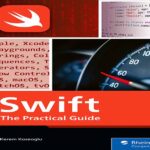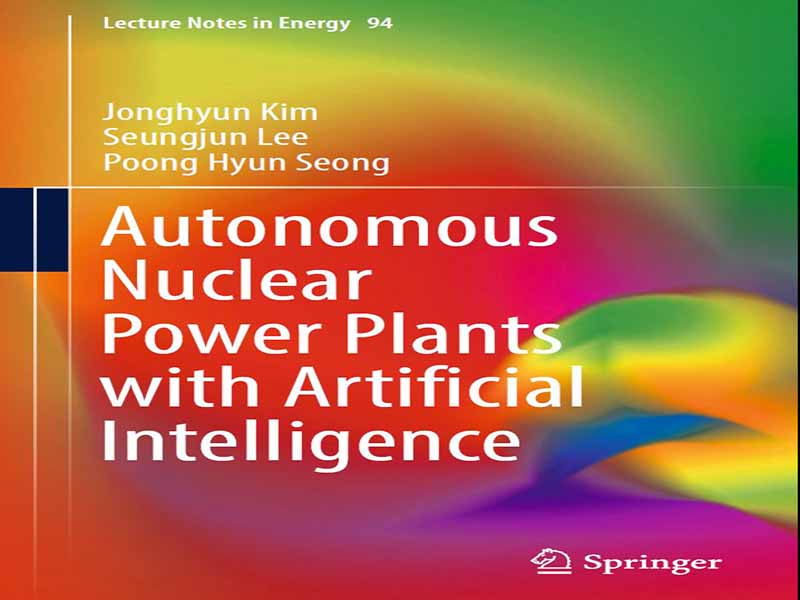- عنوان: Autonomous Nuclear Power Plants with Artificial Intelligence
- نویسنده: Jonghyun Kim, Seungjun Lee, Poong Hyun Seong
- حوزه: نیروگاه
- سال انتشار: 2023
- تعداد صفحه: 280
- زبان اصلی انگلیسی
- نوع فایل: pdf
- حجم فایل: 9.81 مگابایت
اولویت اصلی یک نیروگاه هستهای (NPP) ایمنی است. در واقع، ایمنی یک نگرانی فراگیر در کل چرخه عمر یک NPP، از طراحی آن تا از رده خارج کردن آن است. اما در یک سیستم پیچیده در مقیاس بزرگ با تعداد زیادی از اجزا مانند NPP، شناسایی همه آسیبپذیریها و دستیابی به سطح کاملی از ایمنی آسان نیست. همانطور که حوادث شدید TMI-2، چرنوبیل و فوکوشیما نشان داد، یک وضعیت اضطراری NPP به دلیل یک علت واحد رخ نمیدهد، بلکه به دلیل ترکیبی پیچیده از سختافزار، نرمافزار، اپراتورهای انسانی، تصمیمگیرندگان و غیره است. تحقیقات نشان داده است که خطای انسانی بیش از نیمی از فراوانی آسیب به هسته، یک معیار ریسک رایج، را به خود اختصاص میدهد و همچنین مشخص است که عوامل انسانی علت مستقیم یا غیرمستقیم اکثر حوادث هستهای در تاریخ بودهاند.
یکی از رویکردهای افزایش ایمنی NPPها، توسعه سیستمهای پشتیبانی اپراتور برای کاهش خطاهای انسانی پنهان با بهینهسازی حجم کار مورد نیاز اپراتورها یا خودکارسازی بخشی از وظایف آنها است. در واقع، تحقیقات در مورد کاربرد هوش مصنوعی (AI) در نیروگاههای هستهای برای دههها انجام شده است، اما پیشرفتهای کمی در واقع در نیروگاههای هستهای واقعی منعکس شده است. با وجود این، فناوری هوش مصنوعی اکنون به دلیل افزایش پردازش دادهها و پیشرفت در طراحی سختافزار، واحدهای پردازش گرافیکی و روشهای مرتبط، دوباره به طور ویژه مورد توجه قرار گرفته است. این امر منجر به رشد انفجاری تحقیقات مربوط به تکنیکهای هوش مصنوعی در صنعت هستهای در سالهای اخیر شده است. چنین تلاشهای جهانی برای بهکارگیری تکنیکهای هوش مصنوعی در نیروگاههای هستهای ممکن است منجر به عملکرد بهتری نسبت به روشهای مرسوم بر اساس ویژگیهای نیروگاههای هستهای، مانند پیچیدگی در عملکرد، رفتارهای پویا و بار زیاد در تصمیمگیری، شود.
این کتاب به نه فصل تقسیم شده است. در بخش اول، فصلهای ۱ و ۲، چارچوب نیروگاه هستهای مستقل و اصول تکنیکهای هوش مصنوعی معرفی میشوند. فصل ۱ یک چارچوب سطح بالا برای یک نیروگاه هستهای مستقل شامل معماری عملکردی سیستمهای عملیاتی مستقل پیشنهاد میکند. این فصل سطوح و زیرعملکردهای چندگانه لازم برای خودکارسازی وظایف اپراتور را تعریف میکند. این چارچوب شامل نظارت، کنترل خودکار، رابط انسان-سیستم خودکار و مدیریت هوشمند عملکردها است. فصل 2 توضیحات اساسی در مورد تکنیکهای مختلف هوش مصنوعی که در کتاب به عنوان یک مرور کلی آمده است، ارائه میدهد. در فصلهای 3 تا 6، روشهای ضروری لازم برای توسعه سیستمهای پشتیبانی اپراتور و سیستمهای عامل خودکار معرفی شدهاند. فصلهای 3، 4 و 5 تکنیکهای مختلف مبتنی بر هوش مصنوعی را برای نظارت بر نیروگاههای هستهای، از جمله اعتبارسنجی سیگنال، تشخیص موقعیتهای غیرعادی و پیشبینی رفتار نیروگاه با استفاده از روشهای یادگیری نظارتشده و بدون نظارت، به کار میبرند. فصل 6 کاربردهای هوش مصنوعی برای کنترل خودکار با استفاده از یادگیری تقویتی برای شرایط عادی و اضطراری همراه با روشهای تحلیل دامنه را ارائه میدهد. در نهایت، در فصلهای 7 و 8، کاربردها معرفی میشوند. فصل 7 نمونهای از یک سیستم عامل خودکار یکپارچه برای یک راکتور آب تحت فشار را ارائه میدهد که چارچوب پیشنهادی را پیادهسازی میکند. در نهایت، فصل 8 به تعامل بین اپراتورها و سیستمهای خودکار میپردازد. اگرچه سیستمهای عامل خودکار به دنبال به حداقل رساندن مداخلات اپراتور هستند، اما نظارت و کنترل دستی توسط اپراتورهای انسانی در نیروگاههای هستهای به دلایل ایمنی اجتنابناپذیر است. بنابراین، فصل آخر به طراحی رابط سیستم انسان-خودکار و سیستمهای پشتیبانی اپراتور-خودکار میپردازد تا بار کاری اپراتورها را کاهش داده و همچنین آگاهی موقعیتی آنها را در نقش نظارتی افزایش دهد.
انتظار میرود این کتاب اطلاعات مفیدی را برای محققان و دانشجویانی که علاقهمند به بکارگیری تکنیکهای هوش مصنوعی در حوزه هستهای و همچنین سایر صنایع هستند، ارائه دهد. حوزههای بالقوه مختلف کاربردهای هوش مصنوعی و روشهای موجود با مثالهایی مورد بحث قرار گرفتند. رویکردهای سنتی به کاربردهای اخیر هوش مصنوعی بررسی شدند. علاوه بر این، تکنیکهای خاص و نمونههای مدلسازی ارائه شده برای مبتدیان در مطالعات هوش مصنوعی آموزنده خواهد بود. در حالی که تمرکز این کتاب بر عملکرد خودکار نیروگاههای هستهای با هوش مصنوعی بود، روشهای مطرح شده در اینجا برای سایر صنایعی که هم پیچیده و هم از نظر ایمنی حیاتی هستند نیز قابل اجرا خواهد بود.
The top priority of a nuclear power plant (NPP) is safety. Indeed, safety is a ubiquitous concern over the whole life cycle of an NPP, from its design to decommissioning. But in a complex large-scale system with a huge number of components such as an NPP, it is not easy to identify all vulnerabilities and achieve a perfect level of safety. As the TMI-2, Chernobyl, and Fukushima severe accidents demonstrated, an NPP emergency does not occur by a single cause but rather by a complicated combination of hardware, software, human operators, decision-makers, and so on. Research has revealed that human error takes up more than half of core damage frequency, a common risk metric, and it is also known that human factors were the direct or indirect cause of most nuclear accidents in history.
One of the approaches to enhance the safety of NPPs is to develop operator support systems to reduce latent human errors by optimizing the operators’ required work-load or automating some portion of their tasks. In fact, research into the application of artificial intelligence (AI) to NPPs has been performed for decades, but few develop-ments have actually been reflected in real NPPs. Despite this though, AI technology is now being particularly highlighted again due to increases in data processing and advancements in hardware design, graphics processing units, and related methods. This has led to an explosive growth in recent years of research related to AI tech-niques in the nuclear industry. Such global efforts toward applying AI techniques to NPPs may result in better performance than conventional methods based on the characteristics of NPPs, such as complexity in operation, dynamic behaviors, and high burden in decision-making.
This book is divided into nine chapters. In the first part, Chaps. 1 and 2,the framework of the autonomous NPP and the fundamentals of AI techniques are introduced. Chapter 1 suggests a high-level framework for an autonomous NPP including the functional architecture of the autonomous operation systems. This chapter defines multiple levels and sub-functions necessary for automating oper-ator tasks. The framework consists of monitoring, autonomous control, the human– autonomous system interface, and the intelligent management of functions. Chapter 2 provides fundamental explanations of the various AI techniques appearing in the book as an overview. In Chaps. 3–6, the essential methods necessary for developing operator support systems and autonomous operating systems are introduced. Chapters 3, 4, and 5 apply various AI-based techniques for the monitoring of NPPs including signal vali-dation, diagnosis of abnormal situations, and prediction of plant behavior using both supervised and unsupervised learning methods. Chapter 6 presents AI applications for autonomous control using reinforcement learning for both normal and emergency situations along with domain analysis methods.
Lastly, in Chaps. 7 and 8, applications are introduced. Chapter 7 provides an example of an integrated autonomous operating system for a pressurized water reactor that implements the suggested framework. Lastly, Chap. 8 deals with the interac-tion between operators and the autonomous systems. Even though the autonomous operation systems seek to minimize operator interventions, supervision and manual control by human operators are inevitable in NPPs for safety reasons. Thus, the last chapter addresses the design of the human–autonomous system interface and oper-ator support systems to reduce the task burden of operators as well as increase their situational awareness in a supervisory role.
This book is expected to provide useful information for researchers and students who are interested in applying AI techniques in the nuclear field as well as other indus-tries. Various potential areas of AI applications and available methods were discussed with examples. Traditional approaches to recent applications of AI were examined. In addition, the specific techniques and modeling examples provided would be infor-mative for beginners in AI studies. While the focus of this book was the autonomous operation of NPPs with AI, the methods addressed here would also be applicable to other industries that are both complex and safety-critical.
این کتاب را میتوانید بصورت رایگان از لینک زیر دانلود نمایید.
Download: Autonomous Nuclear Power Plants with Artificial Intelligence




































نظرات کاربران